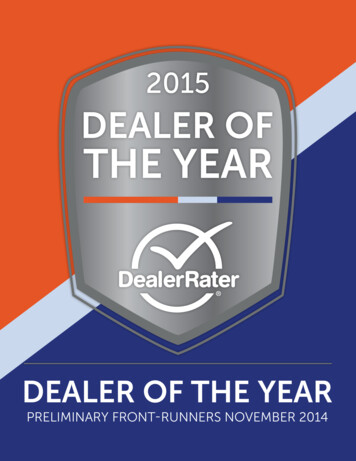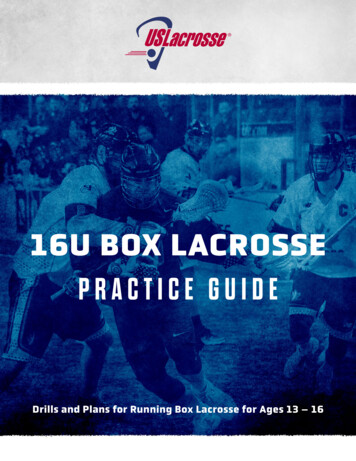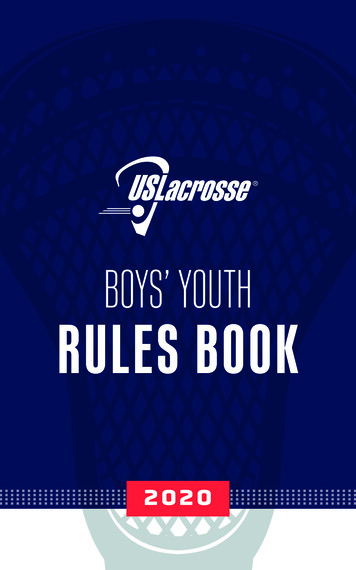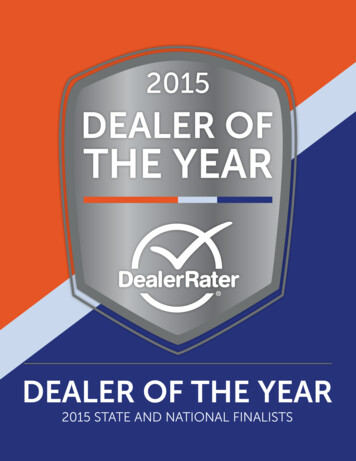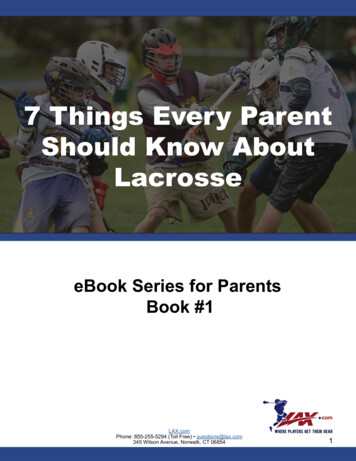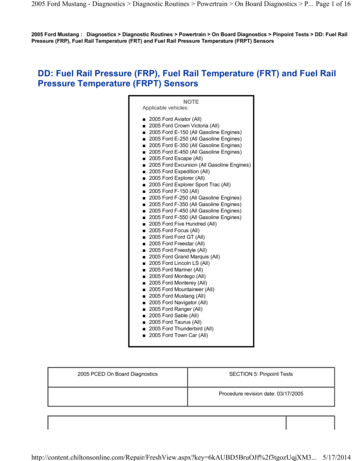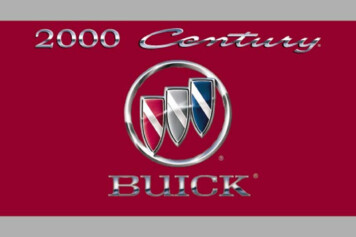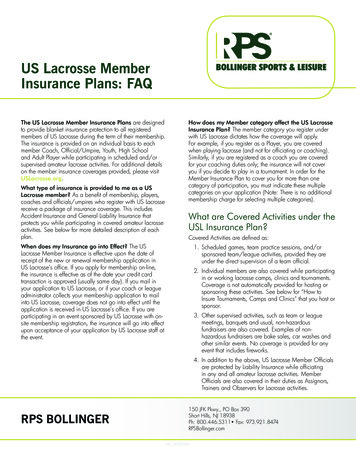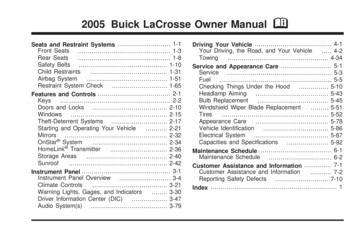
Transcription
2005 Buick LaCrosse Owner ManualSeats and Restraint Systems . 1-1Front Seats . 1-3Rear Seats. 1-8Safety Belts . 1-10Child Restraints. 1-31Airbag System. 1-51Restraint System Check. 1-65Features and Controls . 2-1Keys. 2-2Doors and Locks . 2-10Windows . 2-15Theft-Deterrent Systems . 2-17Starting and Operating Your Vehicle. 2-21Mirrors . 2-32OnStar System. 2-34HomeLink Transmitter. 2-36Storage Areas. 2-40Sunroof. 2-42Instrument Panel . 3-1Instrument Panel Overview . 3-4Climate Controls. 3-21Warning Lights, Gages, and Indicators. 3-30Driver Information Center (DIC). 3-47Audio System(s) . 3-79MDriving Your Vehicle . 4-1Your Driving, the Road, and Your Vehicle. 4-2Towing. 4-34Service and Appearance Care . 5-1Service . 5-3Fuel . 5-5Checking Things Under the Hood. 5-10Headlamp Aiming . 5-43Bulb Replacement. 5-45Windshield Wiper Blade Replacement. 5-51Tires. 5-52Appearance Care. 5-78Vehicle Identification. 5-86Electrical System . 5-87Capacities and Specifications. 5-92.6-1Maintenance ScheduleMaintenance Schedule . 6-2Customer Assistance and Information . 7-1Customer Assistance and Information. 7-2Reporting Safety Defects . 7-10Index . 1
Canadian OwnersA French language copy of this manual can be obtainedfrom your dealer or from:Helm, IncorporatedP.O. Box 07130Detroit, MI 48207GENERAL MOTORS, GM, the GM Emblem, BUICK,and the BUICK Emblem are registered trademarks, andthe name LACROSSE is a trademark of GeneralMotors Corporation.This manual includes the latest information at the time itwas printed. We reserve the right to make changesafter that time without notice. For vehicles first sold inCanada, substitute the name “General Motors of CanadaLimited” for Buick Motor Division whenever it appearsin this manual.Keep this manual in the vehicle, so it will be there if it isneeded while you are on the road. If the vehicle issold, leave this manual in the vehicle.Litho in U.S.A.Part No. 05LACROSSE A First EditioniiHow to Use This ManualMany people read the owner manual from beginning toend when they first receive their new vehicle. If thisis done, it can help you learn about the featuresand controls for the vehicle. Pictures and words worktogether in the owner manual to explain things.IndexA good place to quickly locate information about thevehicle is the Index in the back of the manual. It is analphabetical list of what is in the manual and thepage number where it can be found. 2004 General Motors Corporation. All Rights Reserved.
Safety Warnings and SymbolsThere are a number of safety cautions in this book. Weuse a box and the word CAUTION to tell about thingsthat could hurt you if you were to ignore the warning.You will also find a circlewith a slash through it inthis book. This safetysymbol means “Do Not,”“Do Not do this” or “Do Notlet this happen.”{CAUTION:These mean there is something that could hurtyou or other people.In the caution area, we tell you what the hazard is.Then we tell you what to do to help avoid or reduce thehazard. Please read these cautions. If you do not,you or others could be hurt.iii
Vehicle Damage WarningsVehicle SymbolsAlso, in this manual you will find these notices:The vehicle has components and labels that usesymbols instead of text. Symbols are shown along withthe text describing the operation or informationrelating to a specific component, control, message,gage, or indicator.Notice: These mean there is something that coulddamage your vehicle.A notice tells about something that can damage thevehicle. Many times, this damage would not be coveredby your vehicle’s warranty, and it could be costly. Butthe notice will tell what to do to help avoid the damage.When you read other manuals, you might seeCAUTION and NOTICE warnings in different colorsor in different words.There are also warning labels on the vehicle. They usethe same words, CAUTION or NOTICE.ivIf you need help figuring out a specific name of acomponent, gage, or indicator, reference thefollowing topics: Seats and Restraint Systems in Section 1Features and Controls in Section 2Instrument Panel Overview in Section 3Climate Controls in Section 3Warning Lights, Gages, and Indicators in Section 3Audio System(s) in Section 3Engine Compartment Overview in Section 5
These are some examples of symbols that may be found on the vehicle:v
NOTESvi
Section 1Seats and Restraint SystemsFront Seats .1-3Manual Seats .1-3Six-Way Power Seats .1-4Power Lumbar .1-4Heated Seats .1-5Reclining Seatbacks .1-5Head Restraints .1-7Center Seat .1-7Rear Seats .1-8Split Folding Rear Seat .1-8Safety Belts .1-10Safety Belts: They Are for Everyone .1-10Questions and Answers About Safety Belts .1-14How to Wear Safety Belts Properly .1-15Driver Position .1-15Shoulder Belt Height Adjustment .1-22Safety Belt Use During Pregnancy .1-23Right Front Passenger Position .1-23Center Front Passenger Position .1-24Rear Seat Passengers .1-25Rear Safety Belt Comfort Guides .1-27Safety Belt Pretensioners .1-30Safety Belt Extender .1-30Child Restraints .1-31Older Children .1-31Infants and Young Children .1-33Child Restraint Systems .1-37Where to Put the Restraint .1-40Top Strap .1-41Top Strap Anchor Location .1-43Lower Anchorages and Top Tethers forChildren (LATCH System) .1-43Securing a Child Restraint Designedfor the LATCH System .1-45Securing a Child Restraint in a RearSeat Position .1-46Securing a Child Restraint in the CenterFront Seat Position .1-48Securing a Child Restraint in the RightFront Seat Position .1-48Airbag System .1-51Where Are the Airbags? .1-53When Should an Airbag Inflate? .1-56What Makes an Airbag Inflate? .1-57How Does an Airbag Restrain? .1-57What Will You See After an Airbag Inflates? .1-581-1
Section 1Seats and Restraint SystemsPassenger Sensing System .1-60Servicing Your Airbag-Equipped Vehicle .1-64Adding Equipment to Your Airbag-EquippedVehicle .1-641-2Restraint System Check .1-65Checking the Restraint Systems .1-65Replacing Restraint System Parts After aCrash .1-65
Front SeatsLift the bar located underthe front seat cushion tounlock the seat.Manual Seats{CAUTION:You can lose control of the vehicle if you try toadjust a manual driver’s seat while the vehicleis moving. The sudden movement could startleand confuse you, or make you push a pedalwhen you do not want to. Adjust the driver’sseat only when the vehicle is not moving.Slide the seat to the desired position and release thebar. Try to move the seat back and forth to make sure itis locked in place.1-3
Six-Way Power SeatsPower LumbarIf your vehicle has power seats, the controls are locatedon the outboard sides of the seat cushions.Your vehicle may have power lumbar. The control islocated on the outboard side of the driver’s seat cushion. To move the entire seat forward or rearward, movethe control forward or rearward. To raise or lower the entire seat, move the controlup or down. To raise or lower the front of the seat, move thefront of the control up or down. To raise or lower the rear of the seat, move therear of the control up or down.1-4Press the front of the control to increase lumbarsupport. Press the rear of the control to decreaselumbar support.Keep in mind that as your seating position changes, asit may during long trips, so should the position ofyour lumbar support. Adjust the seat as needed.
Heated SeatsReclining SeatbacksIf your vehicle has thisfeature, the buttons arelocated on the climatecontrol panel.Press the button once to activate a high heat setting.Both indicator lights above the button will come on.Press the button again to select a lower temperaturesetting. Only one indicator light will come on. Press thebutton a third time to turn the heat off.This feature only works when the ignition is on.Lift the lever located on the outboard side of the seat torelease the seatback, then move the seatback to thedesired position. Release the lever to lock the seatbackin place.1-5
{CAUTION:Sitting in a reclined position when your vehicleis in motion can be dangerous. Even if youbuckle up, your safety belts can not do theirjob when you are reclined like this.The shoulder belt can not do its job because itwill not be against your body. Instead, it will bein front of you. In a crash you could go into it,receiving neck or other injuries.But do not have a seatback reclined if your vehicleis moving.1-6The lap belt can not do its job either. In acrash the belt could go up over your abdomen.The belt forces would be there, not at yourpelvic bones. This could cause seriousinternal injuries.For proper protection when the vehicle is inmotion, have the seatback upright. Then sitwell back in the seat and wear your safetybelt properly.
Head RestraintsAdjust the head restraint so that the top of the restraintis closest to the top of the occupant’s head in eachfront seat. This position reduces the chance of a neckinjury in a crash. Push the release button, located underthe head restraint, to lower the head restraint.Center SeatYour vehicle may have a front center seat. This seatcan be converted to a storage area by loweringthe armrest. See Center Console Storage Area onpage 2-41.For information on safety belts for this position, seeCenter Front Passenger Position on page 1-24.1-7
Rear Seats2. Pull forward on theseatback tab locatedon the outboard sideof the rear seatcushion to fold theseatback down.Split Folding Rear SeatIf your vehicle has this feature, both sides of the rearseatback can be folded down in the vehicle. Make surethe front seat is not reclined. If it is, the rear seatbackmay not fold down all the way.To lower the rear seatback, follow these steps:This gives direct access to the trunk.{CAUTION:If the seatback is not locked, it could moveforward in a sudden stop or crash. That couldcause injury to the person sitting there. Alwayspress rearward on the seatback to be sure itis locked.1. Disconnect the rear center lap-shoulder belt latch, ifequipped, by using a pointed object to press therelease button.1-8
{CAUTION:2. Reconnect the centersafety belt latch plateto the buckle.A safety belt that is improperly routed, notproperly attached, or twisted will not providethe protection needed in a crash. The personwearing the belt could be seriously injured.After raising the rear seatback, always checkto be sure that the safety belts are properlyrouted and attached, and are not twisted.To raise the rear seatback, follow these steps:1. Raise the seatback up and make sure it latches.Push and pull on the seatback to be sure it islocked in position.Make sure the safety belt label is pointing to the releasebutton, and that both are facing the front of thevehicle. Make sure the belt is not twisted. Push and pullon the latch plate to be sure it is secure.When the seat is not in use, the seatback should bekept in the upright, locked position.1-9
Safety BeltsSafety Belts: They Are for EveryoneThis part of the manual tells you how to use safetybelts properly. It also tells you some things you shouldnot do with safety belts.{CAUTION:Do not let anyone ride where he or she can notwear a safety belt properly. If you are in acrash and you are not wearing a safety belt,your injuries can be much worse. You can hitthings inside the vehicle or be ejected from it.You can be seriously injured or killed. In thesame crash, you might not be, if you arebuckled up. Always fasten your safety belt,and check that your passengers’ belts arefastened properly too.1-10{CAUTION:It is extremely dangerous to ride in a cargoarea, inside or outside of a vehicle. In acollision, people riding in these areas are morelikely to be seriously injured or killed. Do notallow people to ride in any area of your vehiclethat is not equipped with seats and safetybelts. Be sure everyone in your vehicle is in aseat and using a safety belt properly.Your vehicle has a lightthat comes on as areminder to buckle up. SeeSafety Belt ReminderLight on page 3-32.
In most states and in all Canadian provinces, the lawsays to wear safety belts. Here is why: They work.You never know if you will be in a crash. If you do havea crash, you do not know if it will be a bad one.Why Safety Belts WorkWhen you ride in or on anything, you go as fast asit goes.A few crashes are mild, and some crashes can be soserious that even buckled up, a person would notsurvive. But most crashes are in between. In many ofthem, people who buckle up can survive and sometimeswalk away. Without belts they could have been badlyhurt or killed.After more than 30 years of safety belts in vehicles, thefacts are clear. In most crashes buckling up doesmatter.a lot!Take the simplest vehicle. Suppose it is just a seaton wheels.1-11
Put someone on it.1-12Get it up to speed. Then stop the vehicle. The riderdoes not stop.
The person keeps going until stopped by something. Ina real vehicle, it could be the windshield.or the instrument panel.1-13
Questions and Answers AboutSafety BeltsQ: Will I be trapped in the vehicle after an accidentif I am wearing a safety belt?A: You could be — whether you are wearing a safetybelt or not. But you can unbuckle a safety belt,even if you are upside down. And your chance ofbeing conscious during and after an accident,so you can unbuckle and get out, is much greater ifyou are belted.Q: If my vehicle has airbags, why should I have towear safety belts?or the safety belts!With safety belts, you slow down as the vehicle does.You get more time to stop. You stop over more distance,and your strongest bones take the forces. That is whysafety belts make such good sense.1-14A: Airbags are in many vehicles today and will be inmost of them in the future. But they aresupplemental systems only; so they work withsafety belts — not instead of them. Every airbagsystem ever offered for sale has required the use ofsafety belts. Even if you are in a vehicle that hasairbags, you still have to buckle up to get the mostprotection. That is true not only in frontal collisions,but especially in side and other collisions.
Q: If I am a good driver, and I never drive far fromhome, why should I wear safety belts?A: You may be an excellent driver, but if you are in anaccident — even one that is not your fault — youand your passengers can be hurt. Being a gooddriver does not protect you from things beyond yourcontrol, such as bad drivers.Most accidents occur within 25 miles (40 km) ofhome. And the greatest number of serious injuriesand deaths occur at speeds of less than 40 mph(65 km/h).How to Wear Safety Belts ProperlyThis part is only for people of adult size.Be aware that there are special things to know aboutsafety belts and children. And there are differentrules for smaller children and babies. If a child will beriding in your vehicle, see Older Children on page 1-31or Infants and Young Children on page 1-33. Followthose rules for everyone’s protection.First, you will want to know which restraint systems yourvehicle has.We will start with the driver position.Safety belts are for everyone.Driver PositionThis part describes the driver’s restraint system.1-15
Lap-Shoulder BeltThe driver has a lap-shoulder belt. Here is how to wearit properly.1. Close and lock the door.2. Adjust the seat so you can sit up straight. To seehow, see “Seats” in the Index.3. Pick up the latch plate and pull the belt across you.Do not let it get twisted.The shoulder belt may lock if you pull the beltacross you very quickly. If this happens, let the beltgo back slightly to unlock it. Then pull the beltacross you more slowly.1-164. Push the latch plate into the buckle until it clicks.Pull up on the latch plate to make sure it is secure.If the belt is not long enough, see Safety BeltExtender on page 1-30.Make sure the release button on the buckle ispositioned so you would be able to unbuckle thesafety belt quickly if you ever had to.5. To make the lap part tight, pull down on the buckleend of the belt as you pull up on the shoulder belt.
The lap part of the belt should be worn low and snug onthe hips, just touching the thighs. In a crash, thisapplies force to the strong pelvic bones. And you wouldbe less likely to slide under the lap belt. If you slidunder it, the belt would apply force at your abdomen.This could cause serious or even fatal injuries. Theshoulder belt should go over the shoulder and acrossthe chest. These parts of the body are best able to takebelt restraining forces.The safety belt locks if there is a sudden stop or crash,or if you pull the belt very quickly out of the retractor.1-17
Q: What is wrong with this?{CAUTION:You can be seriously hurt if your shoulder beltis too loose. In a crash, you would moveforward too much, which could increase injury.The shoulder belt should fit against your body.A: The shoulder belt is too loose. It will not give nearlyas much protection this way.1-18
Q: What is wrong with this?{CAUTION:You can be seriously injured if your belt isbuckled in the wrong place like this. In a crash,the belt would go up over your abdomen. Thebelt forces would be there, not at the pelvicbones. This could cause serious internalinjuries. Always buckle your belt into thebuckle nearest you.A: The belt is buckled in the wrong place.1-19
Q: What is wrong with this?{CAUTION:You can be seriously injured if you wear theshoulder belt under your arm. In a crash, yourbody would move too far forward, which wouldincrease the chance of head and neck injury.Also, the belt would apply too much force tothe ribs, which are not as strong as shoulderbones. You could also severely injure internalorgans like your liver or spleen.A: The shoulder belt is worn under the arm. It shouldbe worn over the shoulder at all times.1-20
Q: What is wrong with this?{CAUTION:You can be seriously injured by a twisted belt.In a crash, you would not have the full width ofthe belt to spread impact forces. If a belt istwisted, make it straight so it can workproperly, or ask your dealer to fix it.A: The belt is twisted across the body.1-21
Shoulder Belt Height AdjustmentBefore you begin to drive, move the shoulder beltadjuster to the height that is right for you.Adjust the height so that the shoulder portion of thebelt is centered on your shoulder. The belt shouldbe away from your face and neck, but not falling offyour shoulder.To unlatch the belt, just push the button on the buckle.The belt should go back out of the way.To move it down, pushdown on the releaselever (A) move the heightadjuster to the desiredposition. You can movethe adjuster up justby pushing up on theshoulder belt guide.Before you close the door, be sure the belt is out of theway. If you slam the door on it, you can damageboth the belt and your vehicle.After you move the adjuster to where you want it, try tomove it down without squeezing the release lever tomake sure it has locked into position.1-22
Safety Belt Use During PregnancyRight Front Passenger PositionSafety belts work for everyone, including pregnantwomen. Like all occupants, they are more likely to beseriously injured if they do not wear safety belts.To learn how to wear the right front passenger’s safetybelt properly, see Driver Position on page 1-15.The right front passenger’s safety belt works thesame way as the driver’s safety belt — except forone thing. If you ever pull the shoulder portion of thebelt out all the way, you will engage the child restraintlocking feature. If this happens, just let the belt go backall the way and start again.A pregnant woman should wear a lap-shoulder belt, andthe lap portion should be worn as low as possible,below the rounding, throughout the pregnancy.The best way to protect the fetus is to protect themother. When a safety belt is worn properly, it is morelikely that the fetus will not be hurt in a crash. Forpregnant women, as for anyone, the key to makingsafety belts effective is wearing them properly.1-23
Center Front Passenger PositionLap BeltIf your vehicle has a front bench seat, someone can sitin the center position.To make the belt shorter, pull its free end as shownuntil the belt is snug.Buckle, position and release it the same way as the lappart of a lap-shoulder belt. If the belt is not longenough, see Safety Belt Extender on page 1-30.When you sit in the center front seating position, youhave a lap safety belt, which has no retractor. To makethe belt longer, tilt the latch plate and pull it alongthe belt.1-24Make sure the release button on the buckle is positionedso you would be able to unbuckle the safety beltquickly if you ever had to.
Rear Seat PassengersIt is very important for rear seat passengers to buckleup! Accident statistics show that unbelted people inthe rear seat are hurt more often in crashes than thosewho are wearing safety belts.Rear passengers who are not safety belted can bethrown out of the vehicle in a crash. And they can strikeothers in the vehicle who are wearing safety belts.Lap-Shoulder BeltAll rear seat positions have lap-shoulder belts. Here ishow to wear one properly.1. Pick up the latch plate and pull the belt across you.Do not let it get twisted.The shoulder belt may lock if you pull the beltacross you very quickly. If this happens, let the beltgo back slightly to unlock it. Then pull the beltacross you more slowly.2. Push the latch plate into the buckle until it clicks.Pull up on the latch plate to make sure it is secure.When the shoulder belt is pulled out all the way,it will lock. If it does, let it go back all the way andstart again. If the belt is not long enough, seeSafety Belt Extender on page 1-30.Make sure the release button on the buckle ispositioned so you would be able to unbuckle thesafety belt quickly if you ever had to.1-25
3. To make the lap part tight, pull down on the buckleend of the belt as you pull up on the shoulder part.The lap part of the belt should be worn low and snug onthe hips, just touching the thighs. In a crash thisapplies force to the strong pelvic bones. And you wouldbe less likely to slide under the lap belt. If you slidunder it, the belt would apply force at your abdomen.This could cause serious or even fatal injuries. Theshoulder belt should go over the shoulder and acrossthe chest. These parts of the body are best able to takebelt restraining forces.1-26
The safety belt locks if there is a sudden stop or acrash, or if you pull the belt very quickly out ofthe retractor.{CAUTION:You can be seriously hurt if your shoulder beltis too loose. In a crash, you would moveforward too much, which could increase injury.The shoulder belt should fit against your body.Rear Safety Belt Comfort GuidesRear shoulder belt comfort guides may provide addedsafety belt comfort for older children who have outgrownbooster seats and for some adults. When installed ona shoulder belt, the comfort guide positions the beltaway from the neck and head.There is one guide for each outside passenger positionin the rear seat. Here is how to install a comfortguide and use the safety belt:1. Pull the elastic cord out from between the edge ofthe seatback and the interior body to remove theguide from its storage clip.To unlatch the belt, just push the button on the buckle.1-27
2. Slide the guide under and past the belt. The elasticcord must be under the belt. Then, place the guideover the belt, and insert the two edges of thebelt into the slots of the guide.1-283. Be sure that the belt is not twisted and it lies flat.The elastic cord must be under the belt and theguide on top.
{CAUTION:A safety belt that is not properly worn may notprovide the protection needed in a crash. Theperson wearing the belt could be seriouslyinjured. The shoulder belt should go over theshoulder and across the chest. These parts ofthe body are best able to take belt restrainingforces.4. Buckle, position and release the safety belt asdescribed in Rear Seat Passengers on page 1-25.Make sure that the shoulder belt crosses theshoulder.To remove and store the comfort guides, squeeze thebelt edges together so that you can take them out of theguides. Pull the guide upward to expose its storageclip, and then slide the guide onto the clip. Turnthe guide and clip inward and slide them between theseatback and the interior body, leaving only theloop of the elastic cord exposed.1-29
Safety Belt PretensionersSafety Belt ExtenderYour vehicle has safety belt pretensioners. They are onthe buckle end of the safety belts for the driver andright front passenger. They help the safety belts reducea person’s forward movement in a moderate tosevere frontal and near frontal crash.If the vehicle’s safety belt will fasten around you, youshould use it.Pretensioners work only once. If they activate in acrash, you will need to get new ones, and probably othernew parts for your safety belt system. See ReplacingRestraint System Parts After a Crash on page 1-65.1-30But if a safety belt is not long enough, your dealer willorder you an extender. It is free. When you go in toorder it, take the heaviest coat you will wear, sothe extender will be long enough for you. To help avoidpersonal injury, do not let someone else use it, anduse it only for the seat it is made to fit. The extender hasbeen designed for adults. Never use it for securingchild seats. To wear it, just attach it to the regular safetybelt. For more information, see the instruction sheetthat comes with the extender.
Child RestraintsOlder ChildrenQ: What is the proper way to wear safety belts?A: If possible, an older child should wear alap-shoulder belt and get the additional restraint ashoulder belt can provide. The shoulder beltshould not cross the face or neck. The lap beltshould fit snugly below the hips, just touching thetop of the thighs. It should never be worn overthe abdomen, which could cause severe or evenfatal internal injuries in a crash.Accident statistics show that children are safer if theyare restrained in the rear seat.In a crash, children who are not buckled up can strikeother people who are buckled up, or can be thrownout of the vehicle. Older children need to use safetybelts properly.Older children who have outgrown booster seats shouldwear the vehicle’s safety belts.1-31
Q: What if a child is wearing a lap-shoulder belt,but the child is so small that the shoulder beltis very close to the child’s face or neck?A: If the child is sitting in a seat next to a window,move the child toward the center of the vehicle.Also see Rear Safety Belt Comfort Guides onpage 1-27. If the child is sitting in the center rearseat passenger position, move the child toward thesafety belt buckle. In either case, be sure thatthe shoulder belt still is on the child’s shoulder, sothat in a crash the child’s upper body wouldhave the restraint that belts provide.{CAUTION:Never do this.Here two children are wearing the same belt.The belt can not properly spread the impactforces. In a crash, the two children can becrushed together and seriously injured. A beltmust be
You can lose control of the vehicle if you try to adjust a manual driver's seat while the vehicle is moving. The sudden movement could startle and confuse you, or make you push a pedal when you do not want to. Adjust the driver's seat only when the vehicle is not moving. Lift the bar located under the front seat cushion to unlock the seat.
